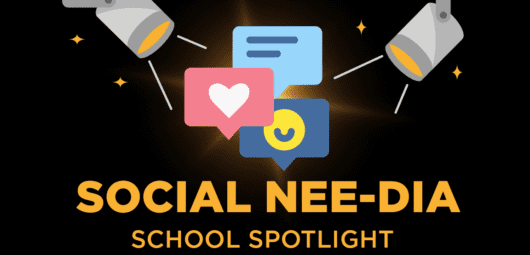Teacher Professional Development: 3 Activity Ideas for School Leaders

The beginning of a teacher professional development day or faculty meeting sets the tone for the learning to take place and the climate for the day. Get your time together off to a good start with a quick activity to get conversations and learning started.
Here are three quick activity ideas for the beginning of a faculty meeting or teacher professional development day. These activities are designed to be facilitated by an educational leader in a face-to-face format.
Professional Development Activity #1: 25 reasons to be proud
How about an activity that will have your teachers feeling proud of the work they have accomplished and the school they are a part of?
“25 reasons to be proud” is a positive activity that will have you all talking about the things that are working well in your school. And that’s important. Research shows a positive school climate has a direct effect on the indicators of school success. Increases in teacher retention and student achievement, as well as decreases in dropout rates and violence, have all been correlated with a positive school climate.
The activity
Kicking off a search for things that are working well begins with faculty. In “The Ten-Minute Inservice,” education authors Todd Whitaker and Annette Breaux suggest principals conduct an activity with teachers asking each to identify 25 reasons to be proud of the school.
After teachers have individually identified the reasons they are proud of their school, a master list of the top 25 reasons can be compiled. The master list can be signed by all of the teachers and building administrators and displayed so that students, parents, and visitors become aware of all the good things happening at the school.
Whitaker and Breaux note: “With this one simple activity, you have helped remind teachers that what they do matters; you have encouraged them to consider all that is positive about the school; you have helped make your environment even more positive; you have created a simple way for everyone who enters the school to know what is good and right with the school; and you have created a daily reminder for students and teachers to continue to take pride in their school and in themselves.”
Professional Development Activity #2: Understanding student goal orientations
Here’s an activity that will get everyone thinking about the different student goal orientations and how students are motivated differently. Teachers will consider the way classroom policies and practices influence student goal orientations.
Setting up the activity
To get started, briefly introduce what is meant by student goal orientation and the three types. For this, we’re referencing the Jan Chappius text “Seven Strategies of Assessment for Learning.”
Goal orientation is a term researchers use to define different ideas students have about why they are doing their work in school.
A student’s goal orientation generally falls into one of three categories:
- Learning Orientation: A student with this orientation works to improve and get better. The goal is to find out what is not known and master it.
- Performance Orientation: Also called the ego orientation, the student with this orientation is motivated to prove a level of ability or to hide a perceived lack of ability.
- Task-Completion Orientation: A student with this orientation works to get the job done and get a grade. This student wants to know when it is due or how many points it is worth.
The activity
- Place teachers in groups of three.
- Give each group the set of three Goal Orientation activity cards (download PDF). Each teacher in the group takes one card and reads it.
- Regroup teachers into three large groups according to the goal orientation card they selected.
- Each group of teachers should talk about how a student might act, talk, and respond in a classroom when working from that goal orientation. Teachers might be able to think of examples from the classroom.
- Each of the three groups should brainstorm a list of teacher practices that might encourage students to work from that goal orientation.
- Teachers then return to their original 3-person group and share the practices they discussed for their goal orientation.
Wrapping it up and providing support
Ask teachers to share anything from the small group discussions that they think is important for the whole group to hear or discuss.
Share some of the practices that can move students toward a learning goal orientation. Teachers can support a learning goal orientation by:
- Establishing clear learning targets that are understood by students.
- Focusing instruction, learning activities, and diagnostic assessments on the learning targets.
- Ensuring assessment practices treat learning as a progression where mistakes are part of learning.
- Allowing sufficient time for practice and feedback before a graded event.
- Teaching students to self-assess and how to set meaningful goals for further learning.
The culture of the classroom is important for developing a learning goal orientation. Teachers who hold high expectations for all students and insist on hard work support a learning goal orientation. When the students in a classroom assume responsibility for producing high-quality work, initiate improvements, make revisions, add details, and help peers, they are more likely to work from a learning goal orientation.
Ask teachers if there are certain practices they intend to adopt or discontinue as a result of the activity, and allow time at the next teacher work day or meeting to report back about what worked.
Professional Development Activity #3: Using ‘noticing’ for professional growth
This activity helps teachers learn about noticing noteworthy instructional practices when viewing classroom instruction. Teachers will watch a classroom video and look for distinct behaviors, then discuss what they saw.
Setting up the activity
First, a little background on the concept of “noticing.”
In education, noticing has been defined several ways. For our purposes, noticing refers to what prospective and practicing teachers focus their attention on, how they reason about what they see, and their abilities to reflect on teaching strategies and consider alternatives.
Teacher noticing can be utilized in two ways:
- For instructional purposes by teachers who notice what and how their students are learning and use what they notice to adjust instruction
- For professional growth by teachers who observe other teachers in action, analyze what the teachers are doing, and why they are acting in those ways in order to improve their instructional practice.
In order to utilize noticing constructively, the teacher must first learn to analyze lessons, examine the relationship between the mode of instruction and student learning, assess the results of instruction and then use all of the information to come to a determination of what to do next to meet the needs of students in the classroom.
It can be helpful for teachers to use a “lens” as they watch videos of others in the act of teaching. The group or individuals might select a lens through which to filter the video in order to focus attention on a particular teaching behavior.
The activity
- Break teachers into small groups.
- Assign a “lens” to each group. Each lens is a performance indicator, or a specific teaching behavior. The teachers will watch for that specific performance indicator during the video. (To use NEE indicators for this activity, download and provide this handout.)
- As teachers watch the video below, they should mark the time on the video for anything they notice that represents the indicator they’re using as their lens.
- After the video, the small groups should discuss what they saw in terms of their lens and create a list of all the points where they saw the indicator in action.
- Have each group report out to the whole group on what they saw in the video that represented their lens. You might elect to watch the video again with the whole group and stop the video when a certain indicator is noticed.
Wrapping it up
Tie the activity back to the classroom. After the activity, teachers may decide to:
- Create a grade-level or subject-area video club to work on the indicators in their personal teaching practice. Although teachers might be hesitant to be recorded while teaching, video observations are a powerful mechanism for professional growth.
- Select some of the strategies used by the teacher in the video to try in their classrooms.
- Watch additional videos through the lens of indicators to become familiar with the actions that exemplify an indicator.
The Network for Educator Effectiveness (NEE) is a simple yet powerful comprehensive system for educator evaluation that helps educators grow, students learn, and schools improve. Developed by preK-12 practitioners and experts at the University of Missouri, NEE brings together classroom observation, student feedback, teacher curriculum planning, and professional development as measures of effectiveness in a secure online portal designed to promote educator growth and development.


